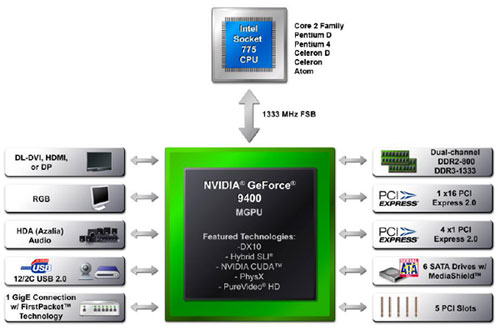Can we split Atoms ?
Can we split Atoms ?
If you remember learning about ION's molecules and atoms at school, you should remember that an Ion is an Atom or molecule which has lost or gained one or more electrons, giving it a positive or negative electrical charge. And that description suits today's preview of the ION platform really well. The small prototype of the NVIDIA ION reference PC we received combines the NVIDIA GeForce 9400 GPU and Intel Atom CPU. One could say a positively charged Atom.
I'll state it once more, prototype, as in not a finished product, and definitely not a design you'll see on the market. This is a technology overview and preview.
We expect that ION will end up in mini-notebooks, netbooks and even mid-range laptops. After looking into its potential, we see a market for mini PCs as well as the Full HD video capability of this device will suit HTPC aficionado's pretty well. There is one big restriction though, you stick to content allowed to be decoded over the GPU like DVD, WMV-HD (DXVA accelerated) and Blu-ray. So that's a pretty big platform where NVIDIA could penetrate certain markets for sure.
[Ed - We have already seen rumours of the IONs first application running in the next revision of the Mac Mini]
But why is this all needed ? Why not just run all that high-def goodness off the processes or already embedded into such that netbook ? Well, almost any netbook is powered by an Intel Atom processor, and while the processor is amazingly dominant for its size, Atom just isnt setting any performance records when it comes to multi-media. Atoms main restriction is in fact its platform chipset, based on Intel 945GC, which we feel is outdated, while NVIDIA's GF9400 is sparkling new and very versatile.

GF9400M Block diagram
The Intel Atom with 945GC chipset offers a very basic experience at best. If we place some specifications in a table and compare .. you'll notice spot on what we are talking about, as the difference is colossal really:
| NVIDIA ION - GF9400 | Intel 945GC | |
| Front Side Bus | >1,333 MHz | >533 MHz |
| Memory freq in MHz | DDR2 800 | DDR3 1333 | DDR2-533 |
| DirectX | 10 | 9c |
| PCI-Express | x16 (one), x1 (four) | x1 (two) |
| USB 2.0 | 12+2 | 8 |
| SATA II | 6 | 2 |
| RAID | 0, 1, 0+1 and RAID 5 | - |
| HD Audio | Yes, 7.1 | No, AC97 |
| Ethernet | 1000/100/10 | 10/100 |
| Display | Dual-link DVI, VGA, HDMI, DP | VGA, DVI, HDMI vendor dependant) |
As you can see, the platform differences are huge, and we haven't even talked about the graphics core that is embedded. See, Intel's Atom 945 chipset can manage many a lot of tasks but a problem for it is simple, HD video playback is just not possible on the Atom (945G) ecosystem because the CPU isnt fast enough to properly decode high bit rate video like VC1, H.264 and MPEG4. When Intel releases their Atom series, NVIDIA saw an opportunity, pairing up that processor with a GPU.
The embedded graphics in the GF9400 chipset is in fact the same 9400 series we know from the newer Apple and Sony VAIO TX series laptops. I have this model VAIO myself, and well .. it's just an awesome platform really as it can decode 1080P High Def video and output 8 channel (7.1 surround) Linear PCM audio over HDMI as well.
In the past we've tested single-core Atoms fighting even decoding 720P videos. And here's where the ION shines like a star. Playing back a 1080p clip encoded as a 40 Mbps MPEG4/AVC file with no noticeable dropped frames or stutters. ION as a platform will handle HD video quite competently, with exceptional image quality.
The design team therefore planted a Atom CPU and GF9400 GPU on a Pico-ATX PCB (motherboard), memory and enough fast and versatile IO on there. The end-result is a very small yet very capable symbiosis of technology.
Though NVIDIA did not share a specific TDP of the GeForce 9400 chipset, it's speculated to be something like 12W TDP for the notebook parts. If that statement is true then it would be roughly 10 Watt less than Intel is currently managing with the Atom platform as a whole, which is great news for one more thing, battery life. We'll check power consumption later on in this article though.
